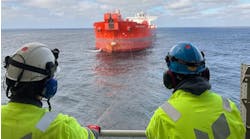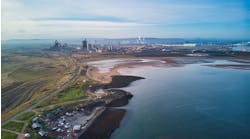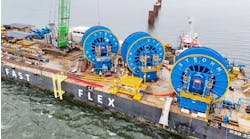Aspen development plan set
BP and Nexen Petroleum plan to bring the Aspen discovery into production by the end of this year. The companies said development will be via subsea completions tied back to a host platform. Nexen said the early production system in the Green Canyon Block 243 project will cost $194 million. The partners last May estimated reserves associated with the Aspen find at 150 MMBOE based on results from the discovery well and two sidetrack appraisal wells. Exploratory wells drilled by the Ocean Victory semi in 3,150 ft water depth confirmed 490 ft of net pay in the Aspen discovery last April.
The discovery is about 5 km from the BP-operated Troika Field, and there is existing infrastructure in the area. Nexen, which had a 20% interest in the project, increased its ownership interest to 60%, and BP remains operator. Nexen will pay incremental development costs to fast-track the field to production.
King Kong/Yosemite, others onstream
Mariner Energy's King Kong/Yosemite project in the Gulf of Mexico is producing. Output is 120 MMcf/d of natural gas with production expected to reach 150 MMcf/d of natural gas. Located in Green Canyon Blocks 472, 473, and 516, King Kong/Yosemite is producing from two subsea wells and will ultimately produce from three subsea wells in 3,800 ft water depths.
All three wells are connected to a subsea manifold then to Agip's Allegheny platform 15 miles away in Green Canyon Block 254, which serves as the host facility. Mariner and Agip each hold 50% interest in Green Canyon Block 472 and 473. Mariner has 44%, Agip has 50%, and Noble Drilling has 6% in Green Canyon Block 516.
Moving northeast, Magnum Hunter Resources' Main Pass 178 No. A-2 well is flowing at 12 MMcf/d and 200 b/d. The Main Pass 178 No. A-1 well was tested at 5 MMcf/d and 800 b/d. Magnum Hunter owns 100% interest in these wells. To the southwest, the South Marsh Island Block 35 No. A-1 well is flowing at 1,100 b/d and 2 MMcf/d. Magnum Hunter owns 37.5% in this Remington Oil and Gas-operated well. And, west of that, the High Island A-153 No. A-2 well is flowing at 5 MMcf/d of equivalent. Magnum Hunter owns 25% in this well operated by Unocal subsidiary Spirit Energy 76.
Kerr-McGee, Newfield report GoM finds
Kerr-McGee made three oil and gas discoveries at the Navajo Field in the Gulf of Mexico's deepwater East Breaks area. Drilling activities at the Navajo, West Navajo, and Northwest Navajo prospects, located on East Breaks Blocks 690, 689, and 646, encountered commercial quantities of hydrocarbons. Combined reserves in Navajo are estimated at 20-30 MMBOE. Kerr-McGee operates the Navajo Field in 4,000 ft water depth with 50% interest, and Ocean Energy holds 50% interest. Navajo is five miles south of the Nansen Field, where production began in January through the world's first truss Spar facility. Operator Kerr-McGee has 50% interest in Nansen. Ocean Energy holds the remaining 50%. The Navajo wells encountered more than 640 ft of net true vertical thickness pay in four separate pay sands. Development of this field is under way as a subsea tieback to Nansen. First production from the Navajo Field is expected in 2Q 2002 at 50 MMcf/d from one well. Production from the other two wells is expected in early 2003.
Newfield Exploration Co. had finds in West Delta and Eugene Island deep-shelf plays. The West Delta Block 21 No. 6 well, drilled to a total depth (TD) of 16,000 ft, encountered a gross hydrocarbon interval of 250 ft with net pay of 165 ft. First production is expected in 4Q 2002. Operator Newfield has 62% interest. The Eugene Island Block 163 No. 1 well was drilled to a TD of 15,521 ft and encountered 35 ft of net gas pay. First production from the discovery, which will be tied back to a Newfield-operated platform at Eugene Island Block 172, is expected in 4Q 2002. Operator Newfield has 82.5% interest. The Eugene Island Block 199 No. A-16 sidetrack was drilled to a TD of 14,484 ft and encountered 40 ft of net gas pay. The well was drilled from Newfield's Eugene Island Block 198 A production platform. The new well was completed and is now online. Operator Newfield has 100% interest. High Island Block 355 No. 1 well was drilled to a TD of 9,500 ft and encountered 135 ft of net gas pay. High Island Block 355 No. 2 well was drilled to a TD of 10,000 ft and found 150 ft of net gas pay. A production facility will be set this year with first production expected in 4Q 2002. Operator Newfield has 82.5% interest.
Hydrocarbons found at Tahiti, Navajo
ChevronTexaco and joint venture partners found oil at the Tahiti prospect in Green Canyon Block 640 in the Gulf of Mexico. The Trans-ocean Sedco Forex Discoverer Deep Seas drilled the well in 4,017 ft water depth to 28,411 ft total depth (TD). Results from the exploratory well indicate the presence of high quality reservoir sand with total net pay exceeding 400 ft. Enterprise Chief Executive Sam Laidlaw said the partners will work together to determine the best plan to evaluate the fuller potential of Tahiti. Green Canyon Block 640 partners are operator ChevronTexaco with 58%, Enterprise with 17%, and PanCanadian with 25%. Shell has bid to buy UK independent Enterprise and so might wind up wih 17% of Tahiti.
Brutus TLP shut in for repairs
Shell E&P shut in its Brutus tension leg platform (TLP) in Green Canyon Block 158 for repairs. Valve failures in the production processing system prompted shut down of the TLP. All systems were de-pressurized. Production remained shut in to conduct an investigation and make repairs. Shell said it used the down time to expand production capacity to 130,000 b/d. Initial indications suggest stimulation fluids from a well may have entered the gas processing system, causing equipment damage. At the time of shut-in, Brutus was producing 60,000 b/d and 90 MMcf/d of natural gas from four wells, with a fifth well shut in. Ongoing drilling operations on the sixth well were unaffected.




